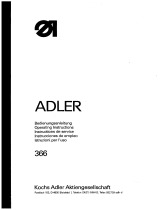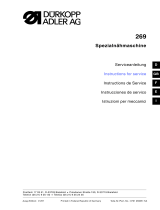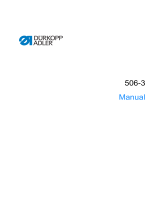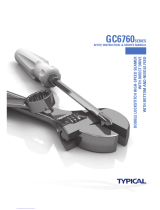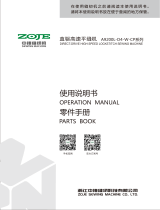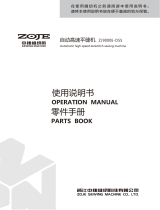Page is loading ...

669
Spezialnähmaschine
Betriebsanleitung
Instruction manual
Postfach 17 03 51, D-33703 Bielefeld • Potsdamer Straße 190, D-33719 Bielefeld
Telefon +49 (0) 521 / 9 25-00 • Telefax +49 ( 0) 521 / 9 25 24 35 • www.duerkopp-adler.com
D
GB
Ausgabe / Edition: Änderungsindex Teile-Nr./Part.-No.:
12/2008 Rev. index: 00.0 Printed in Federal Republic of Germany 0791 669741

Alle Rechte vorbehalten.
Eigentum der Dürkopp Adler AG und urheberrechtlich geschützt. Jede, auch auszugsweise
Wiederverwendung dieser Inhalte ist ohne vorheriges schriftliches Einverständnis der Dürkopp Adler AG
verboten.
All rights reserved.
Property of Dürkopp Adler AG and copyrighted. Reproduction or publication of the content in any manner,
even in extracts, without prior written permission of Dürkopp Adler AG, is prohibited.
Copyright ©
Dürkopp Adler AG - 2008

Foreword
This instruction manual is intended to help the user to become familiar
with the machine and take advantage of its application possibilities in
accordance with the recommendations.
The instruction manual contains important information on how to
operate the machine securely, properly and economically. Observation
of the instructions eliminates danger, reduces costs for repair and
down-times, and increases the reliability and life of the machine.
The instruction manual is intended to complement existing national
accident prevention and environment protection regulations.
The instruction manual must always be available at the machine/sewing
unit.
The instruction manual must be read and applied by any person that is
authorized to work on the machine/sewing unit. This means:
– Operation, including equipping, troubleshooting during the work
cycle, removing of fabric waste,
– Service (maintenance, inspection, repair) and/or
– Transport.
The user also has to assure that only authorized personnel work on the
machine.
The user is obliged to check the machine at least once per shift for
apparent damages and to immediatly report any changes (including the
performance in service), which impair the safety.
The user company must ensure that the machine is only operated in
perfect working order.
Never remove or disable any safety devices.
If safety devices need to be removed for equipping, repairing or
maintaining, the safety devices must be remounted directly after
completion of the maintenance and repair work.
Unauthorized modification of the machine rules out liability of the
manufacturer for damage resulting from this.
Observe all safety and danger recommendations on the machine/unit!
The yellow-and-black striped surfaces designate permanend danger
areas, eg danger of squashing, cutting, shearing or collision.
Besides the recommendations in this instruction manual also observe
the general safety and accident prevention regulations!

General safety instructions
The non-observance of the following safety instructions can cause
bodily injuries or damages to the machine.
1. The machine must only be commissioned in full knowledge of the
instruction book and operated by persons with appropriate training.
2. Before putting into service also read the safety rules and
instructions of the motor supplier.
3. The machine must be used only for the purpose intended. Use of
the machine without the safety devices is not permitted. Observe all
the relevant safety regulations.
4. When gauge parts are exchanged (e.g. needle, presser foot, needle
plate, feed dog and bobbin) when threading, when the workplace is
left, and during service work, the machine must be disconnected
from the mains by switching off the master switch or disconnecting
the mains plug.
5. Daily servicing work must be carried out only by appropriately
trained persons.
6. Repairs, conversion and special maintenance work must only be
carried out by technicians or persons with appropriate training.
7. For service or repair work on pneumatic systems, disconnect the
machine from the compressed air supply system (max. 7-10 bar).
Before disconnecting, reduce the pressure of the maintenance unit.
Exceptions to this are only adjustments and functions checks made
by appropriately trained technicians.
8. Work on the electrical equipment must be carried out only by
electricians or appropriately trained persons.
9. Work on parts and systems under electric current is not permitted,
except as specified in regulations DIN VDE 0105.
10. Conversion or changes to the machine must be authorized by us
and made only in adherence to all safety regulations.
11. For repairs, only replacement parts approved by us must be used.
12. Commissioning of the sewing head is prohibited until such time as
the entire sewing unit is found to comply with EC directives.
13. The line cord should be equipped with a country-specific mains
plug. This work must be carried out by appropriately trained
technicians (see paragraph 8).
It is absolutely necessary to respect the safety
instructions marked by these signs.
Danger of bodily injuries !
Please note also the general safety instructions.

GB
Contents Page:
Preface and General Safety Instructions
Part 1: Operating instructions Class 669
(Edition 12/2008)
1. Product Description ............................................ 3
2. Designated Use ............................................... 3
3. Subclasses .................................................. 4
4. Optional Equipment ............................................ 5
5. Technical Data
5.1 Technicaldatasubclasses ......................................... 7
6. Operation
6.1 Threading the needle thread ........................................ 8
6.2 Adjusting the needle thread tension.................................... 9
6.2.1 Function of the main thread tension and the s upplementary thread tension
in relation to the sewing-foot lift for subclass 669-180312 ...................... 10
6.2.2 Function of the supplementary thread tension in relation to the stroke adjustment
and the Speedomat for s ubclass 669-180312 .............................. 11
6.3 Adjusting the needle thread tension.................................... 12
6.4 Turning the supplementary thread tension on and off for subclasses 669-180010
and 669-180112 ................................................ 12
6.5 Adjusting the thread regulator ....................................... 13
6.6 Winding the bobbin thread ......................................... 14
6.7 Replacing the shuttle bobbin ........................................ 15
6.8 Pre-settingtheshuttlethreadtension................................... 16
6.9 Inserting and replacing the needle .................................... 17
6.10 Raisingthesewingfeet........................................... 18
6.11 Settingthesewingfeetinthehighposition ............................... 19
6.12 Sewingfootpressure ............................................ 19
6.13 Sewingfootstroke.............................................. 20
6.14 Adjusting the stitch length.......................................... 22
6.15 Keypadonthemachinearm........................................ 23

Contents Page:
7. Sew ing
7.1 SewingwithmachinesusingtheFIRclutchpositioningdrive .................... 24
7.2 Sewing with machines using the Efka DC1550/DA321G positioning drive ............. 25
8. Tilting Back the Machine Head...................................... 28
9. Folding Dow n the MG 56-2 Stand .................................... 29
10. Maintenance
10.1 Cleaning and checking ........................................... 30
10.2 Oillubrication................................................. 32

1. Product Description
The DÜRKOPP ADLER 669 is a single-needle double lockstitch
free-arm sewing machine featuring a lower feed, a needle feed and an
alternating foot-upper feed.
Depending on the subclass, it can also come with a thread trimmer,
second stitch length and automatic bartacking.
The maximum stitch length is either 6 mm or 9 mm, depending on the
sewing equipment.
The needle thickness is between 100 – 150 Nm.
·
It is equipped with a large horizontal looper hook.
·
The hook cover has a diameter of 48 mm.
·
There is a maximum clearance of 20 mm under the sewing feet
when the feet are raised.
·
The remaining thread has a length of about 10 mm, depending on
the thread cutting process.
·
The lower feed can be easily deactivated or converted for other
purposes such as edge work.
·
A safety clutch prevents the hook from being displaced or damaged
if the thread gets jammed in the shuttle track.
·
The machine features automatic wick lubrication and a viewing
window in the arm for watching the machine and hook lubrication.
·
All subclasses, excluding those classes without a thread trimmer,
are equipped with a six-way button
An additional pull-down button, within reach of the operator, can
optionally be assigned one of the six different functions.
·
There is also an integrated bobbin w inder.
2. Designated Use
The class 669 machine is a sewing machine head designed for sewing
light to medium-heavy material. Such material is generally made of
textile fibres, but it may also be leather. It is used in the clothing
industry and for domestic and motor-vehicle upholstery.
This sewing machine can also be used to produce technical seams. In
such a case, the operator must assess the possible dangers which
may arise (preferably in conjunction with DÜRKOPP ADLER AG).
Such applications are relatively unusual and varied so that no single
set of criteria can cover them all. The outcome of this assessment may
require appropriate safety measures to be taken.
Generally, only dry material may be s ewn with this sewing machine
head. The material may be no thicker than 10 mm when compressed
by the lowered sewing feet. The material should not contain any hard
objects. If hard objects are present, the machine must be operated with
protective eye wear. We currently do not have such protective eye
wear available for delivery.
The seam is produced with textile-fibre sewing thread, with size
gauges up to 15/3 NeB (cotton), 15/3 Nm (synthetic) or 15/4 N m
(covered yarn).
Before using any other thread, you must assess the dangers
associated with their use and take appropriate safety measures when
necessary.
GB
3

This sewing machine may be set up and operated only in dry,
well-maintained premises. If the sewing machine is used in other
premises which are not dry and well-maintained it may be necessary to
take further precautions which should be agreed in advance (see
EN 60204-31: 1999).
As manufacturers of industrial sewing machines, we proceed on the
assumption that personnel who work on our products will have
received training at least sufficient to acquaint them with all normal
operations and with any hazards which these may involve.
3. Subclasses
669-180010 Single-needle double lockstitch free-arm sewing
machine with lower feed, needle feed and alternating
foot-upper feed.
669-180112 Single-needle double lockstitch free-arm sewing
machine with lower feed, needle feed and alternating
foot-upper feed. Also featuring electro-pneumatic
thread trimmer, electro-pneumatic seam bartacking,
and sewing-foot lift.
669-180312 Single-needle double lockstitch free-arm sewing
machine with lower feed, needle feed and alternating
foot-upper feed. Also featuring electro-pneumatic
thread trimmer, electro-pneumatic seam bartacking,
and sewing-foot lift.
Also includes a second stitch length
(electro-pneumatic switchable), two lifting heights
(electro-pneumatic switchable with knee lever) and
an integrated sewing light.
4

GB
5
4. Optional Equipment
The following additional equipment is available for the 669.
Order no. Optional equipment Subclasses
669-180010
669-180112
669-180312
9780 000108 WE-8 maintenance unit for additional pneumatic
equipment
XXX
0797 003031 Pneumatic connection package. For connection of
stand with maintenance unit.
XXX
0867 490010 Operating panel angle bracket
Xoo
9822 510001 Halogen sewing light for the sewing machine head
XXX
9880 867100 Mounting kit for the sewing light
XXX
0798 500088 Sewing light transformer
XXX
9880 867103 Diode sewing light (one diode)
XXX
9880 867102 Integrated sewing light
XXo
9850 001089 Power supply for the integrated and diode sewing
light
XXo
9850 867001 PCB for oil monitoring
Xo
0867 590014 Electro-pneumatic needle cooler, from above
XX
0367 595124 Mechanical sewing-foot lift, with pedal
X
0867 590354 Pneumatic sewing-foot lift
X
0867 590464 Manual seam tacking
oXo
N800 080004 Edge guide, swivelling
XXX
9805 791113 USB memory key (flash drive) for data transfer
with Efka DA321G control unit
XXX
0659 510030 Distance spacer, for mounting additional
equipment
XXX
Stan d
MG55 400384 Stand set MG 53-3.
Table plate: 1200 x 550 mm without cut-out
XXX
MG55 400394 Stand set MG 55-3.
Table plate: 1200 x 550 mm with cut-out
XXX
MG56 400064 Stand set MG 56-2.
Table plate: 1250 x 600, divided, foldable, for
clutch motors
X
MG56 400074 Stand set MG 56-2.
Table plate: 1250 x 600, divided, foldable, for
DC1550
XXX
o = Standard equipment
X = Optional equipment

Further available documents concerning the class 669:
0791 669801 Parts List
0791 669641 Service Instructions
5. Technical Data
Noise level: Workplace-related emission value according to DIN 45635-48-A-1-KL-2:
669-180010 LC = —dB (A)
Stitch length: _ mm Sewing foot stroke: ___ mm Number of stitches: ____ min
-1
Sewing material:
669-180112 LC = —dB (A)
Stitch length: _ mm Sewing foot stroke: ___ mm Number of stitches: ____ min
-1
Sewing material:
669-180312 LC = —dB (A)
Stitch length: _ mm Sewing foot stroke: ___ mm Number of stitches: ____ min
-1
Sewing material:
6

GB
5.1 Technical data subclasses
Subclasses
669-180010
669-180112
669-180312
Type of stitch Lockstitch 301
Hook type horizontal, large
Number of needles 1
Needle system 134-35
Needle thickness, max. 150
(according to E no.) [Nm]
Max. sewing thread thickness:
Needle thread [Nm] 80/3 - 15/3
Bobbin thread [Nm] 80/3 - 20/3
Stitch length [mm]
Forwards 9
Reverse 9
Max. stitch count [min
-1
] 3000 3000 3000
Stitch count whendelivered 2800 3000 3000
[min
-1
]
Max. sewing-foot lift [mm] 9
Max. height of lifted s ewing feet [mm] 20
Operating pressure [bar] 6
Air consumption per work cycle [NL] 0.7
Dimensions (L x W x H) [mm] 600/ 230/ 470
(with attached Efka DC 1550) (600/ 300/ 470)
Weight [kg] 50
(with attached Efka DC 1550) [kg] (54)
7

6. Operation
6.1 Threading the needle thread
Caution: danger of injury !
Turnthemainswitchoff!
The needle should be threaded only when the machine is turned off.
Threading the needle thread
–
Put the reel on the reel stand. Guide the needle thread through the
unwind holder.
The unwind holder must be perpendicular to the reel.
–
Insert the thread through guide 1 and guide 2.
–
Pass the thread clockwise around the pre-tensioner 3.
–
Pass the thread counter-clockwise around the supplementary
tensioner 4.
–
Pass the thread clockwise around main tensioner 5.
–
Pull the thread under the thread take-up lever 8. Thread through
the thread regulator 10 to the thread lever 11.
–
Pass the thread through thread lever 11 and through guides 9, 7
and 6 on the needle bar.
–
Pass the thread through the eye of the needle.
8
1
2
3
4
5
11
10
9
8
7
6

6.2 Adjusting the needle thread tension
Pre-tensioner
When the main thread tensioner 2 and the supplementary tensioner 3
are open, there must still be a slight tension remaining on the needle
thread. This residual tension is created by the pre-tensioner 1.
The pre-tensioner 1 influences both the length of the cut needle thread
and the starter thread for the next seam.
–
Basic adjustment:
Turn dial 4 until its front side is flush with the bolts 5.
–
For a shorter starter thread:
Turn the dial 4 clockwise.
–
For a longer starter thread:
Turn the dial 4 counter-clockwise.
Main tensioner
The main tensioner 2 should be adjusted as little as possible. The
threads’ cross-over point should be in the centre of the material.
If the thread tension is too strong, crimping and thread tearing
canoccur when working with a thin material.
–
Adjust the main tensioner 2 so that you attain a consistent stitch
pattern.
To increase the tension,turn the dial clockwise.
To decrease the tension, turn the dial c ounter-clockwise.
Supplementary tensioner
The switchable supplementary tensioner 3 is used for quick changes to
the thread tension (for example, when working with thicker seams).
–
The supplementary tension 3 should be set lower than the main
tension 2.
GB
9
321
54

Fig. A: Correct thread interlacing in the center of the
material
Fig. B: Needle-thread tension too weak
or
Hook-thread tension too strong
Fig. C: Needle-thread tension too strong
or
Hook-thread tension too weak
6.2.1 The influence of the sewing-foot lift on the main thread tensioner and supplementary thread
tensioner, for subclass 669-180312
Button 1 (see Chapter 6.15) on the machine’s r ow of buttons can be
used to activate or deactivate the supplementary thread tension at any
time. The parameter F-299 must be set to "1" for this to work.
Sew ing-foot lift Sew ing-foot
in the seam lift after the
thread has been cut
Parameter Main thread Supplementary Main thread Supplementary
setting tension thread tension thread
tension tension
F-196=0 0 0 0 0
F-196=1 1 1 0 0
F-196=2 0 0 1 1
F-196=3 1 1 1 1
1 = Thread tension opened mechanically
0 = Thread tension closed mechanically
·
If the supplementary thread tensioner is open, the state of the
sewing-foot lift does not change.
·
If the machine is turned off, the supplementary thread tension
remains at its previously set state.
10

6.2.2 The influence of the stroke adjustment on the supplementary thread tensioner and the Speedomat,
for subclass 669-180312
Button 1 (see Chapter 6.14) on the machine’s r ow of buttons can be
used to activate or deactivate the supplementary thread tension at any
time. The parameter F-255 must be set to “7" for this to work.
Parameter Max. stroke Stroke adjustment
setting. adjustment via knee button
viadialwhentheHP
speed from parameter
F-117 is reached
(Speedomat)
F-197 = 0 1 1
F-197 = 1 0 1
F-197 = 2 1 (*) 0
F-197 = 3 0 0
(*) If the stroke adjustment (max.) is activated via the knee switch and
the HP speed (from parameter F-117) has been reached by the
“Speedomat”, then the supplementary thread tensioner is automatically
activated.
0 = Supplementary thread tension closed mechanically
1 = Supplementary thread tension opened mechanically
·
If the supplementary thread tensioner is closed, the state of the
stroke adjustment does not change.
·
If the machine is turned off, the supplementary thread tension
remains at its previously set state.
Initial control-box settings for the automatic stepped reduction of the
stitch count (Speedomat), using the dial for the height of the alternating
feed stroke:
Parameter 188
Step 01-21 Entire Speedomat range
Step 01-10 Maximum allowed stitch count, parameter
F-111 = 3000 min
1
Step 11-18 Linear step-wise reduction of the maximum
stitch count (Speedomat)
Step 19-21 Maximum allowed stitch count, parameter
F-117 = 1.800 min
1
GB
11

6.3 Opening the needle thread tension
Subclasses
669-180010
When raising the sewing feet by means of the knee lever, the main and
supplementary tensioners are automatically opened.
Subclasses
669-180112, 669-180312
The needle-thread tensioner is automatically opened when the thread
is cut.
6.4 Turning the supplementary thread tension on and off for subclasses 669-180010
and 669-180112
The supplementary thread tension is turned on and off using the
lever 1.
Turning on
–
Pushtheknob2onthelever1totheleft.
Turning off
–
Pushtheknob2onthelever1totheright.
12
21

6.5 Adjusting the thread regulator
Caution: danger of injury !
Turnthemainswitchoff.
Set the thread regulator only with the sewing machine turned off.
The thread regulator 1 is used to c ontrol the quantity of the needle
thread required by the stitch formation.
The best sewing results can only be ensured when using a precisely
adjusted thread regulator.
At the properly adjusted setting, the needle thread loop must be able to
slide over the thickest section of the hook.
–
Loosen screw 2.
–
Change the position of the thread regulator 1.
Thread regulator to the left = more thread.
Thread regulator to the right = less thread.
–
Tighten screw 2.
Settings note:
At the point where the most thread is required, the thread take-up
lever 3 must be pulled up about 0.5 mm from its lower end position.
This occurs when the needle thread loop passes the section of the
hook with the widest diameter.
GB
13
32 1

6.6 Winding the bobbin thread
–
Put the reel on the reel stand. Guide the bobbin thread through the
unwind holder.
–
Pull the thread through guide 5, the tensioner 4, and the guide 3.
–
Clamp the thread behind the blade 6 and tear off.
–
Put the bobbin 1 on the bobbin winder.
The thread does not need to be hand wound around the bobbin.
–
Press the bobbin-winder lever 2 in the bobbin.
–
Sewing
The bobbin-winder lever ends the operation as soon as the bobbin
is full.
The bobbin winder remains in position so that the blade 6 is
properly positioned (refer to the illustration on the right).
–
Take off the full bobbin 1. Clamp the thread behind the blade 6 and
tear off.
–
Put an empty bobbin on the bobbin winder for the next winding
process and press the bobbin lever 2 into the bobbin.
Caution: danger of breakage!
If the thread is not being wound during the sewing operation, the
sewing foot must be set to the raised position and the sewing-foot
stroke must be set to the smallest value.
14
543 21
26

6.7 Replacing the shuttle bobbin
Caution: danger of injury !
Turnthemainswitchoff.
Change the shuttle bobbin only when the sewing machine is switched
off.
Taking off the empty bobbin
–
Raise the needle bar into its high position.
–
Pull out the hook cover 1 and fold down.
–
Lift up the bobbin enclosure hood 2.
–
Take out the upper part of the bobbin enclosure 3 with the bobbin 4.
–
Remove the empty bobbin from the upper part of the bobbin
enclosure 3.
Inserting a full bobbin
–
Put a full bobbin in the upper part of the bobbin enclosure 3.
Please note the rotational direction of the bobbin.
The rotation is correct when the bobbin turns in the opposite
direction of the pulling direction of the thread.
–
Pull the hook thread through the s lot 7 under the tension spring 6
and then through the hole 5.
–
Pull out the tension spring from the bobbin enclosure about 5 cm.
When the thread is being pulled out, the bobbin must rotate in the
direction shown by the arrow.
–
Replace bobbin housing 3.
–
Close bobbin enclosure hood 2.
–
Close the hook cover 1.
Danger of breakage !
Press down firmly on the bobbin housing and make sure that it is
correctly locked in.
GB
15
1
32
3
4
7
6
5
2

6.8 Pre-setting the hook thread tension
Caution: danger of injury !
Turnthemainswitchoff.
Only adjust the hook thread tension when the machine is turned off.
Brake spring
The brake spring 1 is responsible for preventing a bobbin overrun
during a machine stop and when the hook thread is being cut. It cannot
be adjusted!
Setting the tension spring
–
Adjust the tension spring 4 with the adjustment screw 3. Tu rn until
the required tension force is present.
Raising the hook thread tension
–
Turn the screw 3 clockwise.
Decreasing the hook thread tension
–
Turn the screw 3 counter-clockwise.
16
1
2
3
4
/

